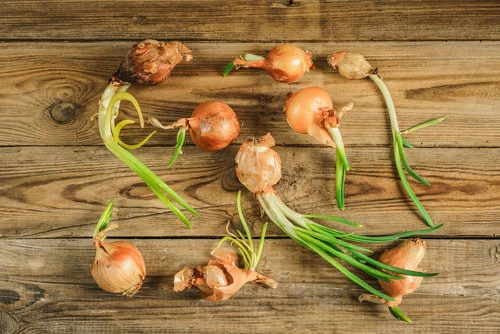My parents taught me how to make do when I didn’t have much. In my childhood, there was always an herb or a bit of plant placed into a glass jar with some water in my mother’s kitchen that was an indelible part of growing up. That’s something that has stuck with me since then, and I also remember doing a lot of recycling and regrowing. These are economic lessons that I can share with my own children now.
We are always looking for ways to reduce our food bills. It gets more expensive to feed a family every day, and anything we can do to reduce the grocery bill is appreciated and put into use in our house. It gives us more money for everything else.
That’s why I want to talk about regrowing food from scraps. This does more than just stretch out the family budget. It also cuts down on the chemicals sprayed foods you are eating, which have been linked to a number of different health problems by the World Health Organization.
Pesticides can be very dangerous of humans, and they can cause cancer, reproductive problems and attacks on the nervous system. All pesticides should be tested fully before they are put into use, but that doesn’t always happen.
It is best to avoid pesticides when possible. We should do our best to treat our food like our medicine, as Hippocrates once suggested.
It can cost a lot of money to grow your own food. You need space, the knowhow and the resources to make it happen. What you may not realize, however, is that you can take scraps from your meals and make things grow. There are some scraps that are better for this kind of recycling than others, and we have picked out a few of them to try.
Potatoes
One of the best foods for regrowing are potatoes. The potato itself isn’t great for regrowing, but the peeling is. You just need some peelings that have eyes on them. These are where the new buds will come from. You can plant them to about the length of your finger into the ground, and you might see a new sprout in a matter of days. Another method is to put some wet paper on the ground and place the peeling facing skyward. Then put some straw down about a metre all around the peeling. The potato will start to grow underneath and push its way upward. You can even harvest the potatoes before the main crop has come up.
Tomatoes
Tomatoes grow easily from seeds that come from the scraps. If you want to make sure that the tomato grows to become like the original, then you should only plant heirlooms or no-hybrid plant seeds. You should save out overripe heirloom tomatoes to enjoy the most success. Take out as many seeds as you need, wash them and let them dry all night long. Then put them on some absorbent paper to dry out all the way. From here, you can place them into an envelope and label it with the date and the tomato. When the weather is right, just takes the seeds out, put it down in a bit of seeding mix and water it regularly. It’s best to keep it in a pot until the seedling starts to sprout a bit.
Lettuce
You will probably have a few leaves left over anytime you make a salad, and those leaves can be used to grow fresh lettuce. You don’t need to waste those leftover leaves; instead, put them into a bowl and place a little water in the bottom. Put that bowl in sunlight and make sure to water the roots twice a week with a misty spray. In three to four days, you should see some new roots and leaves. Once they outgrow the bowl, you can move your lettuce to some well mulched soil situated in the sunlight. You can just keep on doing this for an endless supply of lettuce.
Celery
Celery can be regrown as well. Start by cutting the base of your celery and then place it in some warm water and in sunlight. You will need to put in fresh water each day. Once the outside of the base becomes brown, you will see it feed off the new growth forming in the centre of the celery. Once that happens, you can plant it outside in some potting mix, and you will see visible growth in about a week.
Herbs- Mint, Rosemary, Coriander and Basil
You can regrow these herbs from scraps as well. Take some of the sprig from the leftovers and put in a jar of warm water. Place it somewhere that it can receive sunlight and keep all the leaves above the water level. You can see new root growth in about a week. You can plant it then in a pot or in in your garden. The herbs will not only be great for seasoning your food, but they will also make a great decoration, depending on where you place the pot.
Onion and Garlic
When you keep garlic or onions in a dark and cool place, they will start to soften and grow from the inside out. You may be throwing away a great opportunity whenever you toss these away. Just leave them in the dark for a day or two and then put them out in the garden. It’s so easy, and you will enjoy a steady supply of fresh garlic and onions.
Mandarin Oranges
This will take longer, but you can grow a mandarin tree from a single seed. You need to choose one that grows true to type, and be patient as it matures. You will want to start by taking out the seeds from a ripe Mandarin. Wash those off and drain out the water, then put them to dry. You can hold onto this seed until the early summer or late spring. Then place them in a pot of soil until they get big enough to plant out. Water them every day, and when they are large enough you can find a place that will be large enough to accommodate a tree.
Avocado
You probably toss the avocado seed directly into the bin after you eat it, but you can regrow the fruit from its massive seed. Just keep it in water for about a week. Hold the seed over the water with some toothpicks underneath it to help it float. Set that glass in cool place and add more water as needed. Six weeks later, you should see a stem starting to grow. Cut that stem down to half when it gets to about 15 cms and leave it until leaves appear. Once those leaves pop out, you can plant the seed. Just be sure to leave the top half of the seed open to the air.
Lemongrass
Lemongrass is essential to Thai cuisine, but you may have some trouble finding it in stores. The cheapest and best way to have access to lemongrass is to grow your own. Keep a little of the roots in a glass of water and expose it to the sun. Once new roots form, you can plant it outside.
Squash, Zucchini and Pumpkin
These are very simple to grow from scraps. You don’t need to prepare very much. Just use heirloom seeds or non-hybrid seeds for true to type growth. They can grow practically anywhere, you can even throw them under a bit of dirt and leave the out to form themselves.
Ginger and Turmeric
You can regrow these plants that are often used for their recuperative effects. Once they begin to sprout you can put them in some potting soil. You can lift it after just a few days, once it has grown fronds. The root is excellent for cooking, and you can use the leftovers to start again.
If you can grow your own veggies, it is much easier to keep them pesticide free. If you grow food fresh you will get a lot more nutrients from them, and they will taste better. Is there anything better than getting your ingredients from your own back yard?
These tips should help you enjoy more fresh, organic produce for you and your family without having to spend a lot of money. You can just take the scraps that would naturally be left over and start new plant growth. Try to use organic vegetables whenever possible for this method.



